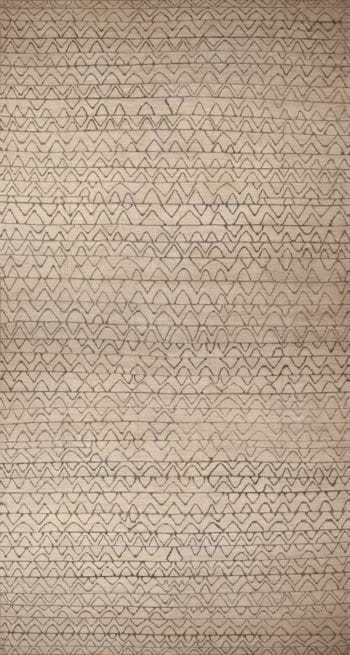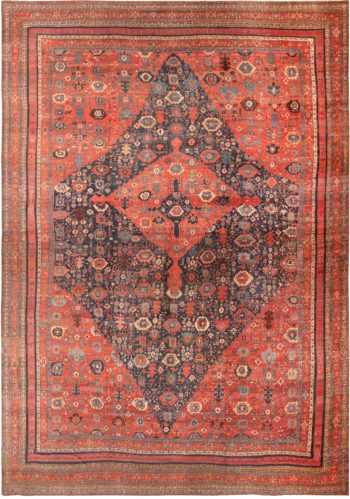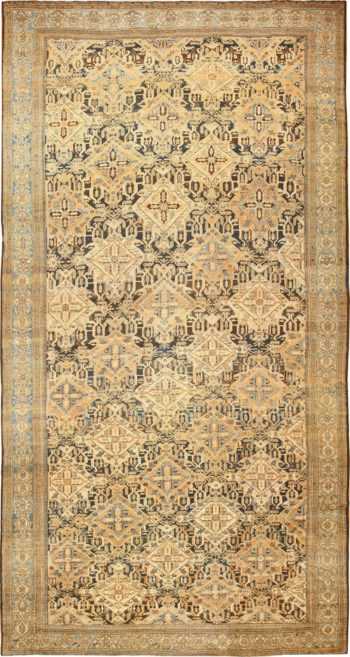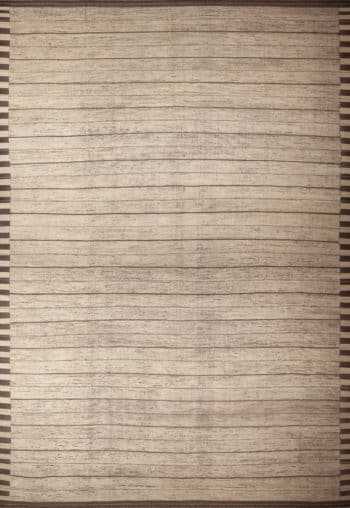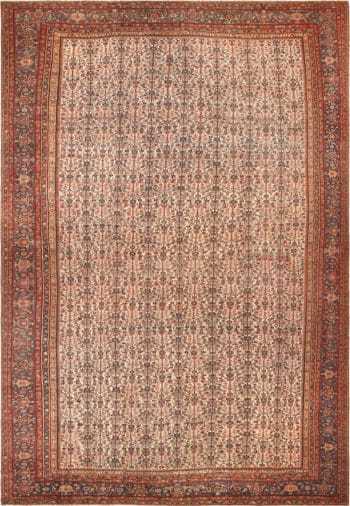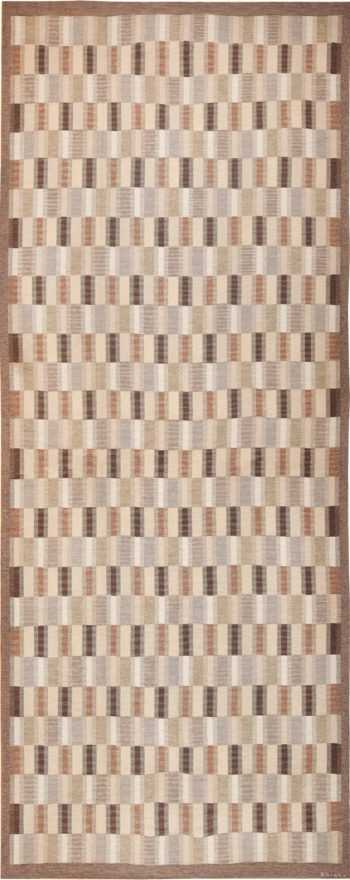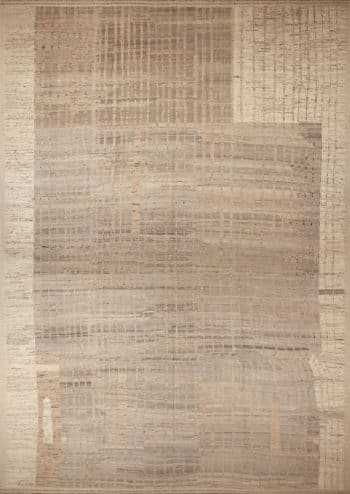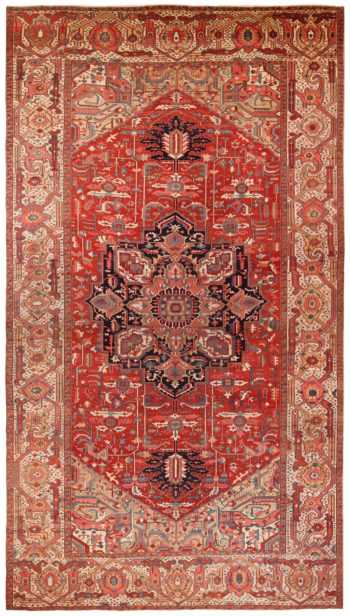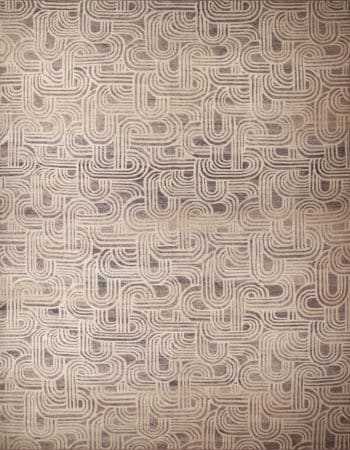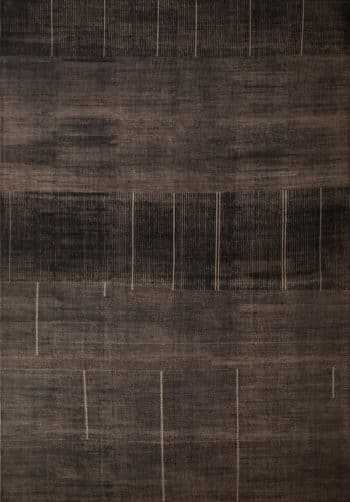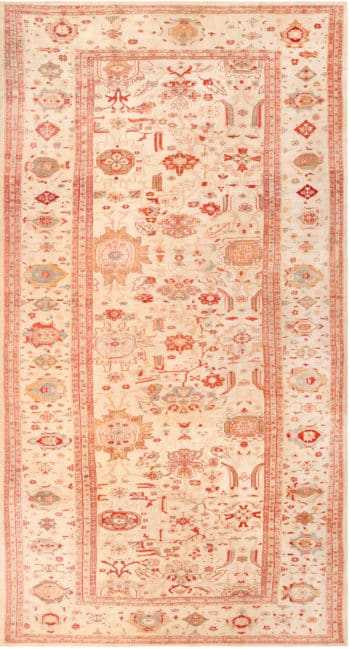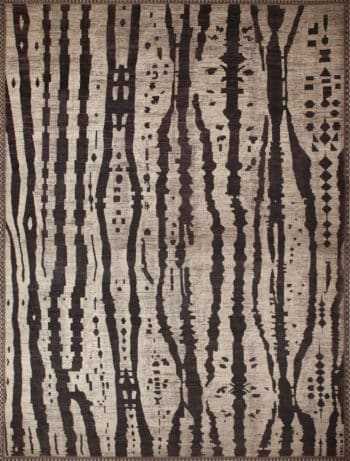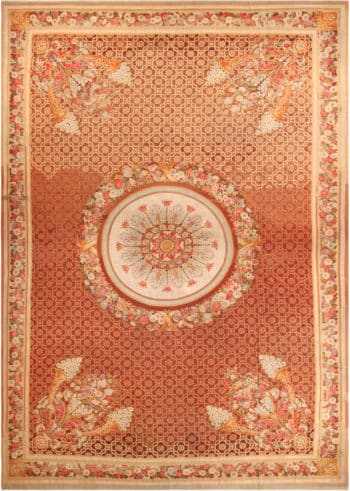Geometric Rugs
View our current selection of antique rugs with geometric designs below:
Oversized Light Ivory Cream Tribal Chevron Modern Rug 11862
$33,740.00Size: 17 ft x 31 ft 5 in (5.18 m x 9.58 m)Durable Rustic Palace Size Antique Tribal Persian Bidjar Rug 71773
$145,000.00Size: 19 ft 5 in x 31 ft 3 in (5.92 m x 9.52 m)Rich Red Jewel Tone Oversized Antique Allover Design Indian Agra Rug 72240
$165,000.00Size: 18 ft 2 in x 30 ft 10 in (5.54 m x 9.4 m)Tribal Antique Oversized Persian Bakhtiari Geometric Rug 48042
$96,000.00Size: 15 ft x 30 ft (4.57 m x 9.14 m)Oversized Antique French Art Deco Carpet 70262
$95,000.00Size: 19 ft 4 in x 29 ft (5.89 m x 8.84 m)Oversized Neutral Cream Minimalist Geometric Stripe Modern Rug 11864
$35,595.00Size: 19 ft 7 in x 28 ft 10 in (5.97 m x 8.79 m)Ivory Background Allover Design Oversized Antique Persian Farahan Rug 72238
$45,000.00Size: 18 ft x 28 ft 10 in (5.49 m x 8.79 m)Vintage Oversize Scandinavian Brita Grahn Kilim Rug 49804
$66,000.00Size: 11 ft 8 in x 28 ft 10 in (3.56 m x 8.79 m)Oversized Light Neutral Earthy Tribal Geometric Nomadic Modern Rug 11856
$30,240.00Size: 17 ft 7 in x 27 ft 3 in (5.36 m x 8.31 m)Oversized Antique Persian Heriz Serapi Rug 70433
$175,000.00Size: 15 ft 4 in x 26 ft 8 in (4.67 m x 8.13 m)Oversized Neutral Purple Grey Art Deco Hollywood Regency Style Modern Rug 11863
$33,768.00Size: 20 ft 4 in x 26 ft 4 in (6.2 m x 8.03 m)Rich Earthy Charcoal Brown Color Tribal Geometric Modern Rug 11857
$30,310.00Size: 18 ft 3 in x 26 ft 4 in (5.56 m x 8.03 m)Oversized Antique Spanish Savonnerie Rug 72914
$69,000.00Size: 15 ft 10 in x 26 ft (4.83 m x 7.92 m)Oversized Light Ivory Cream and Soft Neutral Grey Tribal Geometric Modern Rug 11859
$31,500.00Size: 19 ft x 26 ft (5.79 m x 7.92 m)Oversized Luxurious Ivory Antique Persian Ziegler Sultanabad Rug 72353
$265,000.00Size: 14 ft x 26 ft (4.27 m x 7.92 m)Oversized Bold Ivory Cream and Charcoal Color Tribal Geometric Modern Rug 11860
$31,150.00Size: 19 ft 5 in x 25 ft 7 in (5.92 m x 7.8 m)Large Scale Tribal Oversized Blue Antique Persian Malayer Rug 71133
$135,000.00Size: 13 ft 9 in x 25 ft 7 in (4.19 m x 7.8 m)Oversized Ivory Cream Brown Tribal Geometric Modern Area Rug 11861
$32,690.00Size: 20 ft 6 in x 25 ft 3 in (6.25 m x 7.7 m)Oversized 19th Century Antique French Aubusson Rug 47241
Size: 17 ft 2 in x 25 ft (5.23 m x 7.62 m)Blue Oversized Modern Oriental Traditional Indian Agra Rug 72158
$29,400.00Size: 15 ft x 24 ft 9 in (4.57 m x 7.54 m)Brown Modern Moroccan Design Hallway Runner Rug 61007
$5,355.00Size: 2 ft 7 in x 24 ft 7 in (0.79 m x 7.49 m)Oversized Tribal Antique Turkish Oushak Shabby Chic Rug 50199
Size: 16 ft 3 in x 24 ft 7 in (4.95 m x 7.49 m)Oversized Light Ivory Cream Neutral Light Grey Tribal Design Modern Rug 11858
$30,940.00Size: 20 ft x 24 ft 4 in (6.1 m x 7.42 m)Large Sale Allover Design Blue Oversized Antique Persian Malayer Rug 71134
$125,000.00Size: 13 ft x 24 ft (3.96 m x 7.32 m)
Learn More About Antique Geometric Rugs
What is a geometric rug?
A geometric rug is a type of rug that features patterns and designs inspired by geometric shapes and forms. These shapes can include squares, rectangles, circles, triangles, diamonds, hexagons, and more. Geometric rugs often incorporate repeated patterns or symmetrical arrangements, creating a visually striking and balanced design.
The patterns on geometric rugs can be simple and minimalistic or intricate and complex, depending on the style and preference. They can be found in a wide range of colors, but like neutral rugs, geometric rugs also often come in more subdued and subtle color palettes.
Geometric rugs have become increasingly popular in contemporary and modern interior design, as they can add a sense of order, structure, and sophistication to a space.
Here are some common types of geometric rug designs:
- Chevron: Zigzag patterns that create a V-shaped design, often in a repeating sequence.
- Moroccan: Inspired by traditional Moroccan tile patterns, these rugs typically feature diamond or trellis motifs.
- Greek Key: This pattern consists of repeating right-angled keys or frets, forming a continuous and interconnected design.
- Herringbone: A pattern that resembles the bones of a herring fish, characterized by its V-shaped weaving arrangement.
- Hexagonal: Rugs with hexagon-shaped patterns, often creating a honeycomb-like effect.
- Abstract Geometric: Contemporary designs that take inspiration from geometric shapes but are more freeform and artistic in their arrangement.
A geometric area rug can be used in various rooms and settings, such as living rooms, dining areas, bedrooms, or even in offices and commercial spaces. These more angular rugs are versatile and can work well with both modern and traditional decor styles.
When choosing a geometric rug, consider the size, color, and pattern to ensure it complements the overall design of the room and adds visual interest to the space.
What makes geometric rugs so special?
Geometric rugs are special for several reasons, and their popularity is driven by a combination of design aesthetics, versatility, and cultural significance.
Here are some factors that contribute to the specialness of geometric rugs:
- Contemporary Design: Geometric patterns have a timeless and modern appeal. They often feature clean lines, symmetry, and repetition, making geometric rugs a popular choice for contemporary interior design. The simplicity and versatility of geometric designs allow these rugs to complement a wide range of decor styles.
- Versatility: Geometric rugs can easily adapt to different interior design themes. Whether used in minimalist, modern, traditional, or eclectic settings, these rugs add a sense of structure and visual interest to the space. Their versatility makes them suitable for various rooms within a home or for commercial spaces.
- Expressive Patterns: Geometric rugs often feature bold and expressive patterns that can become focal points in a room. The dynamic shapes and contrasting colors in these patterns can evoke a sense of energy and movement, contributing to the overall atmosphere of a space.
- Visual Interest: The repetition of geometric shapes creates visual interest and depth. Whether it’s a simple grid, chevron, herringbone, or complex tessellations, the patterns draw attention and engage the viewer. Geometric rugs can break up monotony in a room and provide a focal point.
- Cultural and Historical Significance: Geometric patterns are prevalent in various cultures and have been used in art and design throughout history. Traditional geometric motifs from cultures such as Islamic, Native American, or African can carry cultural significance and historical depth, adding layers of meaning to the rug.
- Timeless Appeal: Geometric designs have a timeless quality that transcends trends. While some patterns may be associated with specific design movements, many geometric motifs have enduring popularity, making geometric rugs a lasting and classic choice for interior decor.
- Customization Options: Geometric rugs often come in a variety of shapes, sizes, and color combinations. This allows for customization, enabling individuals to choose a rug that fits their specific preferences, color scheme, and spatial requirements.
- Balance and Symmetry: Geometric patterns often exhibit a sense of balance and symmetry, creating a harmonious visual effect. This can contribute to a feeling of order and stability in a room, making geometric rugs a popular choice for those seeking a balanced and well-designed space.
The specialness of geometric rugs lies in their ability to combine modern aesthetics, versatility, expressive patterns, cultural richness, and a timeless appeal. Whether used as a statement piece or to complement existing decor, geometric rugs offer a visually captivating and flexible design option for various interior spaces.
How do people decorate around geometric rugs?
Decorating around geometric rugs involves creating a harmonious and visually appealing space that complements the rug’s patterns and design.
Here are some tips for decorating around geometric rugs:
- Neutral Walls: If your geometric rug features bold patterns and vibrant colors, consider keeping the walls in a neutral shade. Neutral walls provide a balanced backdrop that allows the rug to take center stage without overwhelming the space.
- Complementary Colors: Choose furniture and decor items that complement the colors in the geometric rug. Pulling colors from the rug for accent pieces such as throw pillows, curtains, or artwork can help tie the room together.
- Contrast with Solid Colors: If the geometric rug is busy and intricate, balance it out with solid-colored furniture and accessories. This contrast helps create visual interest without making the space too overwhelming.
- Mixing Patterns: If you enjoy a bold and eclectic look, you can mix patterns in your decor. However, be mindful of scale and ensure that the patterns in the rug and other elements in the room don’t clash. Consider using different scales of patterns to create harmony.
- Furniture Placement: Arrange furniture in a way that highlights and complements the geometric patterns of the rug. For example, center a coffee table on the rug or use the rug to define a seating area. Ensure that the rug’s edges are visible and not completely hidden under furniture.
- Layering Rugs: Consider layering your geometric rug with a larger, solid-colored rug underneath. This can create depth and add texture to the room while allowing the geometric rug to remain a focal point.
- Balanced Lighting: Ensure that the room has a balanced and well-distributed lighting scheme. Adequate lighting helps showcase the geometric patterns of the rug and contributes to the overall ambiance of the space.
- Minimalist Approach: If the geometric rug is particularly bold and attention-grabbing, you may opt for a more minimalist approach in other design elements. Simple, streamlined furniture and decor can allow the rug to shine without competing with too many visual elements.
- Accessorize Thoughtfully: Use accessories to enhance the overall design. Consider incorporating geometric patterns in smaller doses, such as through throw pillows or decorative items, to echo the patterns in the rug.
- Consider the Room’s Purpose: Keep in mind the function of the room when decorating around a geometric rug. For example, a living room may benefit from comfortable seating and a balanced arrangement, while a bedroom might focus on creating a serene atmosphere with coordinating decor.
Personal taste plays a crucial role in decorating, so feel free to experiment and adjust these suggestions based on your preferences. The goal is to create a cohesive and visually pleasing space that showcases the beauty of the geometric rug.
Exploring the world of area rugs with geometric designs
Nearly all carpets can be broken down into geometric patterns. Whether carpets feature grand medallions and sinuous vine-scrolls, precise latticework rug patterns or coffered compartments, the geometry and mathematics of each right-angle corner or precisely calculated curve is behind the beauty of the grandest and the smallest elements.
Muslim mathematicians and “geometers” in Persia helped the country create stunning circular medallions, magnificent arabesques and graceful vine-scrolls that flow with ease. Tribal rugs and city area carpets from northwest Persia tend to favor designs based on angular, rectilinear geometry. On the other hand, the famous Sheikh Safi medallion depicted in the famous Ardabil carpet and geometric Gonbad dome medallions all represent a clear understanding of geometric principles and the beauty they represent.
Tribal rug weavers in Turkey, Morocco, the Caucasus and many other regions employ rectilinear motifs that have obvious geometric properties. Whether they are based on the principles of the golden mean or abstract, asymmetric proportions, these carpets are fantastically attractive. Weavers across the globe approach geometric patterns differently.

Geometric Rugs
In Scandinavia, designers and weavers craft precise lozenges and flat-woven Rolakan that feature ruler-straight patterns. In Morocco, weavers have an improvisational, abstract approach that is totally unique. The beauty of geometric carpet patterns is the diversity and limitless ways in which mathematical principles can be used to create decorative patterns with universal appeal. By considering the geometric principles behind each twist and turn, each precise medallion and each beautifully drawn motif, it’s hard to look at antique carpets in the same way. Abstract, informal or elegant, behind each great carpet is a great understanding of geometry and mathematical principles.
These geometric design carpets are woven using straight, linear, vertical, horizontal and diagonal lines, often employing a central medallion. Antique rugs with geometric designs were typically woven using nomadic cultural symbols representing something cherished by the tribe. They can also portray stylized floral patterns as is seen in some Heriz rugs.
Incorporating geometric rugs in interior design is a great way to add instant visual interest and a pop of color. And achieving this trend through the use of geometric rugs is a great way to try it out without having to make a big commitment- like wall paper! The brilliance of geometrics is that they can be achieved in almost any style, from vintage rugs, to Antique Persians. Therefor it is a trend for all, no matter the theme of the room!
Geometric Designs and Geometry Based Patterns In Islamic Art
Geometric patterns are a critical element found in Islamic art of all types. The other two non-figurative types of decoration found most commonly in Islamic design are calligraphy and floral based patterns. The popularity of all three patterns is largely due to their symbolic quality, where the human face and body are not represented. You can see these elaborate, intricate abstract designs on almost any surface of Islamic architecture and major decorative elements, such as antique geometric rugs, as well as in just about any other type of object.
Geometric design ornamentation was not just found in Islamic design during the antique period. For hundreds of years, the Greeks, Romans, and Iranian Sassanian used geometric elements in their designs as well. Many Islamic artisans took inspiration from these older geometric designs, appropriating certain elements, eventually elaborating on them to create a distinctive style all their own. The ultimate goal of using these abstract design elements was to create unity and order with an artistic touch. Other influences on this style included the intellectual donations from significant mathematicians, scientists and astronomers from throughout the Islamic world.
Islamic geometric design starts with simple forms like the square and the circle. Artisans then combine simple forms, duplicate them, interlace them, and rearrange them into elaborate designs. This intricate form of abstract expression is a distinct signature feature found in Islamic art and design. And these complex patterns don’t follow any strict rules of geometry or design. The free flowing repetition and complexity offers almost infinite freedom to the designer.
Due to the easy movement of the geometric patterns, artists often incorporate other types of ornamentation into the overall design. They use calligraphy amidst or next to complex geometric movements, making them a part of the overall pattern. Geometric patterns allow for repetitive motifs and symmetry that compare favorably with the so-called arabesque style common to floral designs.
Islamic design often relies on four different shapes to create more complex patterns. The first is the circle and interlaced circles. The second is squares and other four-sides polygons. The third is the star pattern, which is a more complex arrangement of triangles and squares within a circle. The fourth is multi-sided polygons such as hexagons and octagons. Artisans repeat these patterns to create any number of different shapes and visual textures. Due to the sheer complexity, these elaborate designs don’t fit easily into any one category.
Explore the antique geometric rugs from Nazmiyal and you will see that many are vastly different from one another. That said, all these Geometric carpets will your interior design in their own unique way.

